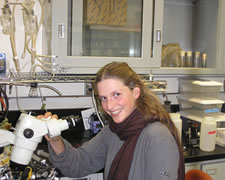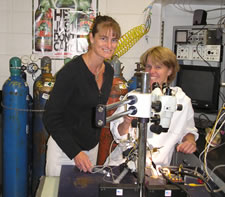Tadpoles used in SIDS research at UAF
By Sonja Bickford, College of Natural Science and Mathematics
June 2006
![]()

UAF photo by Todd Paris
Taylor uses the tadpoles as a model to investigate how organisms control breathing.
![]()

UAF photo by Todd Paris
Located in the Arctic Health Research Building on the Fairbanks campus, Taylor’s lab
is one of several where neurobiological research takes place.
![]()

These data indicate that exposure to alcohol or nicotine during development prevents
tadpoles from responding appropriately to increases in carbon dioxide or decreases
in oxygen.
![]()

Photo by Barbara Taylor
Andrea Croll’s work in Barbara Taylor’s neurobiology lab influenced her university
studies.
![]()

Photo by Jim Warner
Barbara Taylor taught Michelle Boisvert how to use the electrophysiology rig to conduct
research.
In a West Ridge laboratory a UAF scientist and her students are investigating the control of breathing in tadpoles, research which may one day help explain or even prevent sudden infant death syndrome, or SIDS.
Using the tadpole brainstem as a model, Assistant Professor Barbara Taylor is examining how the brain regulates breathing. "It’s not about tadpole breathing," said Taylor. "It’s about what tadpoles can show us about the development of breathing control in animals in general, and people in particular."
Taylor is researching possible causes of SIDS, a breathing failure that claims the life of nearly one out of every 1,000 babies in the United States. Throughout the U.S., SIDS is the leading cause of death between the first and 12th months of life. Taylor and five other UAF investigators, part of the Alaska Basic Neuroscience Program, recently received a five-year grant from the National Institutes of Health. Taylor received almost $1 million from the grant for her project.
"The tadpoles are a model we can use in experiments that would be difficult in rats or mice and impossible in humans," said Taylor, who is based in the Institute of Arctic Biology at UAF. "The brainstem, which sets the rhythm of breathing, is remarkably similar in tadpoles and humans. What we learn from our experiments on tadpoles may help us explain and prevent SIDS."
In Alaska the occurrence of SIDS is twice the national average, and the occurrence among Alaska Natives is nearly four times the national average, which makes SIDS research especially relevant at UAF.
![]()

UAF photo by Todd Paris
Using a microscope, Taylor conducts surgery to isolate the extremely small tadpole
brainstem while keeping the tissues alive.
The likelihood of SIDS increases with prenatal exposure to smoking or alcohol. In one series of experiments Taylor and her students added either alcohol or nicotine to the tadpoles’ aquarium water to mimic prenatal exposure to these substances to determine how such exposure influences the brainstem’s control of breathing.
Researchers in Taylor’s laboratory can isolate a tadpole brain and keep it alive and "breathing" for up to three days. With a complicated procedure like this, one might expect only highly trained scientists to be working in Taylor’s lab. Not so. Undergraduates also have the opportunity to conduct hands-on research. During the three years that Taylor has been at UAF, 10 undergraduates have worked on research projects with her. Her students have even presented their research at national conferences, such as the National Institute of Neurological Disorders and Stroke meeting of the Special Neuroscience Research Program.
As part of the tadpole research program, undergraduates Michelle Boisvert and Andrea Croll investigated effects of developmental exposure to nicotine and alcohol. Their projects used the isolated tadpole brainstem to investigate whether early exposure to alcohol or nicotine made the brain less able to respond to conditions that normally increase the drive to breathe. These students were supported by undergraduate research fellowships from the Alaska IDeA Networks for Biomedical Research Excellence, or Alaska INBRE.
Boisvert, who completed two semesters of individual study with Taylor, said, "The best part of becoming involved in undergraduate research is that I realized I want to continue doing research.
"All of us in the Taylor lab feel fortunate to have been given the opportunity to experience research directly."
"Participating in research is both challenging and rewarding," Boisvert said. "All of us in the Taylor lab feel fortunate to have been given the opportunity to experience research directly. We encourage others to take advantage of the multitude of research opportunities at UAF."
When she was first asked if she was interested in doing undergraduate research, Croll didn’t know how to answer. "Isn’t that reserved for graduate students and lab technicians?" she asked Taylor. Croll soon decided to make undergraduate research a significant portion of her university studies, completing three semesters of individual study with Taylor.
![]()

UAF photo by Todd Paris
The procedure to isolate the tadpole brainstem requires intense concentration and
steady hands.
Taylor began conducting research as an undergraduate herself at the University of British Columbia. "I was in the right place at the right time," she said with a smile. "My invertebrate biology professor was looking for an undergraduate student to pursue a gee-I-wonder type of research question." Her first project investigated how environment affects the rate at which a snail’s feeding organ wears down. Not only was this Taylor’s first research project, it resulted in publication of her first scientific article as the lead author.
"When it comes to getting research funded by a federal agency like the NIH," said Taylor, "the research question must have human impact." Since her undergraduate research experiences, she has pursued topics that have a clear impact on the general public. However, she has never abandoned the inquisitive approach that first introduced her to research.
"Those are my favorite questions, and they make the best introduction to research for students," Taylor said.
When a new undergraduate student approaches Taylor to ask about getting involved in research, she offers an extensive list of possible topics for consideration. Many of the projects relate to her SIDS research, but some are clearly the result of gee-I-wonder thinking.
"You cannot be afraid of wacky ideas," said Taylor. "Sometimes that’s how real breakthroughs are discovered."
Undergraduates in Taylor’s lab have worked on projects investigating the effects of alcohol on learning and memory, metabolic suppression in liver cells and freeze tolerance in the Alaska wood frog, in addition to the research on control of breathing.
"These projects ... are exciting because they have the potential to lead us in new directions."
"These are not watered-down projects designed for undergraduates," Taylor said. "These projects grow from the tangential thinking that occurs as we pursue our main research questions. They are exciting because they have the potential to lead us in new directions."
Thanks to the NIH award, Taylor has opportunities available for undergraduate and graduate students in her lab. Students interested in conducting important research on SIDS or neurobiology can contact Barbara Taylor.
For more information please contact:
- Barbara Taylor, assistant professor, Department of Biology and Wildlife, Institute of Arctic Biology, (907) 474-2487, ffbet@uaf.edu
- Sonja Bickford, public relations officer, UAF College of Natural Science and Mathematics, (907) 474-6714, s.bickford@uaf.edu
- This research is supported by grants from the National institutes of Health and the Alaska IDEA Network for Biomedical Research Excellence.



